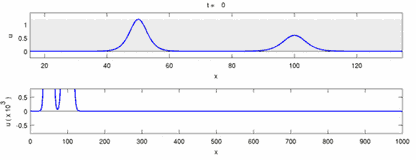Benjamin–Bona–Mahony equation
The Benjamin–Bona–Mahony equation (or BBM equation) – also known as the regularized long-wave equation (RLWE) – is the partial differential equation

The upper graph is for a frame of reference moving with the average celerity of the solitary waves. The envelope of the overtaking waves is shown in grey: note that the maximum wave height reduces during the interaction.
The lower graph (with a different vertical scale and in a stationary frame of reference) shows the oscillatory tail produced by the interaction.[1] Thus, the solitary wave solutions of the BBM equation are not solitons.
This equation was studied in Benjamin, Bona, and Mahony (1972) as an improvement of the Korteweg–de Vries equation (KdV equation) for modeling long surface gravity waves of small amplitude – propagating uni-directionally in 1+1 dimensions. They show the stability and uniqueness of solutions to the BBM equation. This contrasts with the KdV equation, which is unstable in its high wavenumber components. Further, while the KdV equation has an infinite number of integrals of motion, the BBM equation only has three.[2][3]
Before, in 1966, this equation was introduced by Peregrine, in the study of undular bores.[4]
A generalized n-dimensional version is given by[5][6]
where is a sufficiently smooth function from to . Avrin & Goldstein (1985) proved global existence of a solution in all dimensions.
Solitary wave solution
The BBM equation possesses solitary wave solutions of the form:[3]
where sech is the hyperbolic secant function and is a phase shift (by an initial horizontal displacement). For , the solitary waves have a positive crest elevation and travel in the positive -direction with velocity These solitary waves are not solitons, i.e. after interaction with other solitary waves, an oscillatory tail is generated and the solitary waves have changed.[1][3]
Hamiltonian structure
The BBM equation has a Hamiltonian structure, as it can be written as:[7]
- with Hamiltonian and operator
Here is the variation of the Hamiltonian with respect to and denotes the partial differential operator with respect to
Conservation laws
The BBM equation possesses exactly three independent and non-trivial conservation laws.[3] First is replaced by in the BBM equation, leading to the equivalent equation:
The three conservation laws then are:[3]
Which can easily expressed in terms of by using
Linear dispersion
The linearized version of the BBM equation is:
Periodic progressive wave solutions are of the form:
with the wavenumber and the angular frequency. The dispersion relation of the linearized BBM equation is[2]
Similarly, for the linearized KdV equation the dispersion relation is:[2]
This becomes unbounded and negative for and the same applies to the phase velocity and group velocity Consequently, the KdV equation gives waves travelling in the negative -direction for high wavenumbers (short wavelengths). This is in contrast with its purpose as an approximation for uni-directional waves propagating in the positive -direction.[2]
The strong growth of frequency and phase speed with wavenumber posed problems in the numerical solution of the KdV equation, while the BBM equation does not have these shortcomings.[2]
Notes
- Bona, Pritchard & Scott (1980)
- Benjamin, Bona, and Mahony (1972)
- Olver (1979)
- Peregrine (1966)
- Goldstein & Wichnoski (1980)
- Avrin & Goldstein (1985)
- Olver, P.J. (1980), "On the Hamiltonian structure of evolution equations", Mathematical Proceedings of the Cambridge Philosophical Society, 88 (1): 71–88, Bibcode:1980MPCPS..88...71O, doi:10.1017/S0305004100057364
References
- Avrin, J.; Goldstein, J.A. (1985), "Global existence for the Benjamin–Bona–Mahony equation in arbitrary dimensions", Nonlinear Analysis, 9 (8): 861–865, doi:10.1016/0362-546X(85)90023-9, MR 0799889
- Benjamin, T. B.; Bona, J. L.; Mahony, J. J. (1972), "Model Equations for Long Waves in Nonlinear Dispersive Systems", Philosophical Transactions of the Royal Society of London. Series A, Mathematical and Physical Sciences, 272 (1220): 47–78, Bibcode:1972RSPTA.272...47B, doi:10.1098/rsta.1972.0032, ISSN 0962-8428, JSTOR 74079
- Bona, J. L.; Pritchard, W. G.; Scott, L. R. (1980), "Solitary‐wave interaction", Physics of Fluids, 23 (3): 438–441, Bibcode:1980PhFl...23..438B, doi:10.1063/1.863011
- Goldstein, J.A.; Wichnoski, B.J. (1980), "On the Benjamin–Bona–Mahony equation in higher dimensions", Nonlinear Analysis, 4 (4): 665–675, doi:10.1016/0362-546X(80)90067-X
- Olver, P. J. (1979), "Euler operators and conservation laws of the BBM equation", Mathematical Proceedings of the Cambridge Philosophical Society, 85: 143–160, Bibcode:1979MPCPS..85..143O, doi:10.1017/S0305004100055572
- Peregrine, D.H. (1966), "Calculations of the development of an undular bore", Journal of Fluid Mechanics, 25 (2): 321–330, Bibcode:1966JFM....25..321P, doi:10.1017/S0022112066001678
- Zwillinger, D. (1998), Handbook of differential equations (3rd ed.), Boston, MA: Academic Press, pp. 174 & 176, ISBN 978-0-12-784396-4, MR 0977062 (Warning: On p. 174 Zwillinger misstates the Benjamin–Bona–Mahony equation, confusing it with the similar KdV equation.)